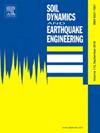离心模型试验中不同连接刚度平行隧道间交叉通道的地震反应
IF 4.2
2区 工程技术
Q1 ENGINEERING, GEOLOGICAL
引用次数: 0
摘要
交通隧道通常在邻近的平行隧道之间设有交叉通道,以方便物资/人员运输和疏散。显然,在极端条件下,如地震事件,保持交叉通道的结构完整性和功能是至关重要的。由于交叉通道的空间结构,其与运行隧道的连接将是其地震反应的关键,也是增强其抗震能力的研究课题。本研究采用离心模型试验,研究了地铁系统隧道-穿越通道结构中柔性连接、刚性连接和形状记忆合金(SMA)连接三种不同刚度的连接方式及其对抗震性能的影响,分别反映了现浇混凝土、管片拼装和创新连接方式。结果表明,无论采用何种连接方式,隧道-横贯通道连接处的最大应变始终出现在连接处的中部。与刚性连接相比,柔性连接的最大应变明显更低,而刚性连接的结构完整性更高。与刚性连接相比,SMA连接具有较强的能量吸收和耗散能力,保持了结构的完整性,同时最大应变较低,显著降低了隧道-穿越通道结构局部区域的应力集中。本文章由计算机程序翻译,如有差异,请以英文原文为准。
Seismic response of cross-passages between parallel tunnels with varied connection rigidities in centrifuge model tests
Traffic tunnels normally have cross-passages between parallel tunnels with close proximity to facilitate materials/human transportation and evacuation. It is obviously essential to maintain the structural integrity and functionality of cross passages under extreme conditions, such as seismic events. Due to the spatial configuration of the cross passage, its connection to running tunnels would be a key point to its seismic response and the subject of research in terms of enhancing the seismic resilience. This study adopted centrifugal model tests to investigate three types of connections with different rigidities and their influences on seismic performance of tunnel-cross passage structures in subway systems: flexible connections, rigid connections, and Shape Memory Alloy (SMA) connections, reflecting respectively cast-in-site concrete, segment assembling, and an innovative connection. The results indicated that regardless of the connection method used, the maximum strain at the tunnel-cross passage junction consistently occurs at the middle of the junction. The flexible connection exhibited a significantly lower maximum strain compared to the rigid connection, while the rigid connection demonstrated a higher degree of structural integrity. The SMA connection, with its energy absorption and dissipation capabilities, maintained structural integrity comparable to that of the rigid connection while exhibiting a lower maximum strain and significantly reducing stress concentration in localized areas of the tunnel-cross passage structure.
求助全文
通过发布文献求助,成功后即可免费获取论文全文。
去求助
来源期刊

Soil Dynamics and Earthquake Engineering
工程技术-地球科学综合
CiteScore
7.50
自引率
15.00%
发文量
446
审稿时长
8 months
期刊介绍:
The journal aims to encourage and enhance the role of mechanics and other disciplines as they relate to earthquake engineering by providing opportunities for the publication of the work of applied mathematicians, engineers and other applied scientists involved in solving problems closely related to the field of earthquake engineering and geotechnical earthquake engineering.
Emphasis is placed on new concepts and techniques, but case histories will also be published if they enhance the presentation and understanding of new technical concepts.
 求助内容:
求助内容: 应助结果提醒方式:
应助结果提醒方式:


